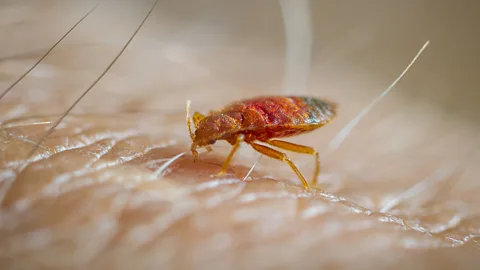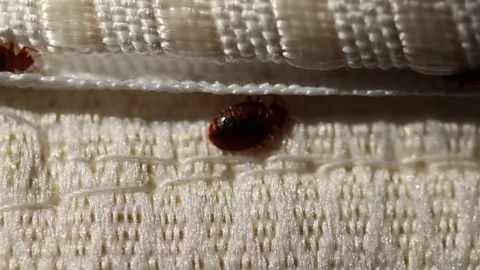Why are bed bugs so difficult to deal with?
 Getty Images
Getty ImagesBed bugs around the world are developing resistance to insecticides, and infestations are making headlines. How do we deal with them?
France is currently in the grip of a bed bug invasion.
This year, in Paris, bed bugs have been reported in schools, trains, hospitals and cinemas. But the infestation has been gathering pace for some time. In 2020, an entire unit in a French hospital had to close after a patient was admitted carrying bed bugs. The decision to close the unit was taken after investigations using a sniffer dog revealed that four rooms were infested. The closure lasted 24 days, and cost approximately US$400,000 (£333,000) to treat.
It appears to be part of a "global resurgence" of bed bugs that has seen the creatures – small, oval-shaped insects smaller than a grain of rice – becoming a growing problem in cities around the world over the past two decades. Global travel – which has allowed the biting insects to leap continents hidden amongst the luggage of oblivious aircraft passengers – has made it easier for them to spread. But once they gain a foothold somewhere, a recent study suggests they may also be getting harder to treat.
In 2005, Warren Booth was a young postdoc researcher in North Carolina, when he began doing a seemingly strange thing. He contacted pest companies and asked them to send him common bed bugs, known as Cimex lectularius. Between 2005 to 2009, he managed to collect 161 examples from 38 US states, each taken from a separate infestation. He intended to study them, but his research was cut short when he was given a job as a geneticist by the University of Tulsa.
Fifteen years later, he teamed up his graduate student Cari Lewis, who had amassed a collection of 233 bed bugs taken from US states between 2018 to 2019. Together they had an impressive stockpile. But what to do with it? Being geneticists, they began to sequence the bugs' DNA.
They were looking for mutations in a region of the genome that codes for the sodium channel. This channel is essential for nerve function – in bed bugs and humans alike. It sits inside the cell membrane of every neuron in the body. When it opens, it lets positively charged sodium atoms, or ions, flow from the outside of the neuron to the inside. This causes the neuron to "spike'", allowing messages to be relayed around the body.
Sodium channels are essential for survival, but some drugs stop them working properly. These include the banned pesticide DDT, and pyrethroid insecticides – the latter of which is a common over-the-counter remedy for bed bugs. Both bind to sodium channels and stop them from closing.
 Getty Images
Getty Images"The nerve continually fires and the animal dies of paralysis," says Booth, now an associate professor of urban entomology at Virginia Tech University in Blacksburg, US.
Over the years, bed bugs have acquired three different mutations in the genes coding for sodium channels, which prevents insecticides from binding to them. We don't know exactly when the mutations developed, but they have been around since at least the 1950s, after the widespread use of DDT in World War Two.
However, until now the extent these mutations are present in the bed bug population has been difficult to measure.
Booth and Lewis's study showed that 36% of the older bed bugs collected in the US between 2005-2009 had a single mutation in their sodium channel gene, while 50% had acquired two mutations. Just 2.5% of the population had no mutations, and were therefore susceptible to insecticides.
When do bed bugs bite
Bed bugs are most active during a five-hour period overnight – between 12am and 5am. That's no accident – we're likely to be in deep sleep, and less likely to wake and interrupt feeding.
The insects hone in on sleeping humans with the help of two cues – carbon dioxide (CO2) emissions and body heat. The bugs can sense CO2 from around 3ft (0.9m) away, and body heat slightly closer.
However, you don't have to be sleeping close to their borrows to be bitten – the bugs will wander several metres during the night in search of a host.
"Whenever you have one of the mutations it results in a several hundred-fold resistance to pyrethroid insecticides," says Booth. "If you have both mutations that can ramp up to around 16,000-fold. So, it means you're not going to kill them. You can pour a bucket load of insecticides on them and it's still not going to have an effect."
In the more modern bedbug samples from 2018-2019, 84% of the bed bugs had acquired two mutations in their sodium channel gene, giving them total protection. Not one single bed bug from the more recent samples in the US were susceptible to insecticides.
"We saw a change in frequency of not the single mutation – the single mutation was always present – but the change in the frequency of having both mutations, so therefore that higher level of resistance," says Booth. "Pretty much every bed bug population you see nowadays has both mutations, which is really bad because you're not going to kill them. It means you can't go down to your local hardware store and buy an over-the-counter insecticide and expect that to do anything – you really need to get professional pest control."
 Getty Images
Getty ImagesBooth and Lewis attribute this change to this widespread use of common over the counter insecticides.
"People don't want to spend hundreds or thousands treating bedbugs if they think they can go down to the hardware store and buy a $5.99 (£4.90) bottle of insecticide to kill them," says Booth. "Unfortunately, what they are doing when they do that is selecting for bed bugs with the mutations, eliminating the ones you can kill, but allowing the ones that you can't kill to thrive."
This means the bed bugs with genes that still make them susceptible to the insecticides don't live to pass on their DNA, while those that are resistant do, allowing the population to rapidly become difficult to get rid of.
So, is the same true in the rest of the world? In 2018, Booth worked with Ondřej Balvín, a ecologist at the Czech University of Life Sciences in Prague. Together they sequenced the genes of 393 bed bugs taken from 131 unique sites of infestation across Europe. Countries sampled included the UK, France, Germany, Switzerland, Italy, Poland, Sweden as well as others. They found that only 3.8% of bed bugs were susceptible to pyrethroid insecticides, with 93.5% of the bed bugs had a single mutation. Unlike the US, however, none had acquired two mutations.
It appears something was happening in US bed bug populations to drive a higher rate of mutation. It’s possible that at some point in the past, a female bed bug with a single mutation randomly adopted a second mutation. As it essentially made the bed bug immune to over the counter insecticides, that variant spread like wildfire amongst the population.
Other studies have also shown that the majority of bed bugs in Australia and Asia have also acquired single mutations. While a recent study confirmed that mutations are now also widespread amongst a tropical bed bug – a separate species known as Cimex hemipterus – in Iran.
How often do bed bugs bite?
During feeding, bed bugs probe the skin with their mouthparts searching for blood-carrying capillaries, researchers at Virginia Tech in the US say.
A bed bug may not find a capillary with the first bite – meaning that victims may suffer several bites from the same bug during a feeding period.
Feeding takes between five and 10 minutes, before the bug retires to a crack to digest its meal. It may take up to a week before it needs to feed again.
"In Europe, Asia and Australia, we find that instead of having both of mutations, bed bugs tended to have only one of those mutations," says Booth. "However it's still bad. These insects are still many hundreds-fold resistant to pyrethroids, so again you're not going to be able to go down your local store and treat this yourself."
You might also like:
More recently, however, researchers have also found double sodium channel mutations in bed bug populations in Paris. One analysis of 156 bed bug specimens collected from buildings around the French capital in 2019 found 73% carried double mutations, which could lie behind the recent plague of the insects in the city.
But all of these studies focus on just one type of resistance, relating to the sodium channel. Research shows that bed bugs are acquiring resistance to other classes of insecticides too by adapting in other ways.
Changing behaviour
In a 2016 study, scientists at Australia's University of Sydney found evidence that bed bugs have developed a thicker exoskeleton to stop pesticides from being absorbed into their body. The higher the bed bug's resistance to pyrethroid insecticides, the thicker its outer shell, or cuticle was. Insects with a cuticle thickness of around 10 micrometres (about a tenth of the thickness of a human hair) were effectively resistant to the insecticide.
According to Booth, bed bugs are also changing their behaviour to avoid being poisoned.
"If you look at a bed bug they are pretty flat to the ground," says Booth. "However, we are seeing some now that can stand up and keep their body off the surface, allowing them to minimise the part of their body that comes into contact with the insecticide."
The behaviour of bed bugs makes them difficult to treat in other ways too. Bed bugs have a tendency to walk around from place to place, and hide in little cracks and crevices, behind wallpaper, under carpets, and amongst household clutter. They may well, therefore, go for long periods without interacting with insecticide residues. This was backed up by a 2020 study, where entomologists Stephen and Alice Kells exposed bed bugs and cockroaches to chlorfenapyr, a relatively new pesticide that bed bugs are not yet completely resistant to.
 Getty Images
Getty ImagesThey used two different products, a liquid spray and an aerosol, and then calculated how much of the chlorfenapyr was actually absorbed into the insect's bodies. They found that for both products, the amount of insecticide taken into the bed bugs' bodies was significantly less than that of the cockroach.
"Exposure of bed bugs to an insecticide is very much a time and dose relationship," says Stephen Kells. "Bed bugs have to be in contact with the residues long enough for the dose to accumulate. So, if they're not applied in the right places or at the right concentrations it's likely that bed bugs will either avoid the exposure altogether, or not be in contact enough to receive a lethal exposure."
Fighting back against bed bugs
What, if anything, can we do to defeat the bed bug? One option is heat treatment, which involves heating up the room or entire property to a high temperature. In a study this year, researchers took 5,400 adult bed bugs from 17 infested locations in Paris. They separated them into five groups and placed each group in different tanks to simulate their natural environment. Some were allowed to set up camp amongst furniture remnants, or scraps of mattresses or blankets, while others were left uncovered in the open air. The researchers then subjected the bugs to heat. All the bugs were killed after just one hour of being heated to 60°C.
However, a 2021 study found that bed bugs have a tendency to simply flee when it gets too hot. This could be a problem, especially in multi-story apartment buildings where bed bugs could simply move out of one apartment into an unsuspecting neighbour's flat.
Heating your house is also not something you should try at home.
"Don't ever try to use heat yourself," says Booth. "I've heard stories of people going to get propane heaters and setting their house on fire. It just doesn't work. You're more likely to kill yourself then do harm to the bed bugs."
Some researchers are coming up with ways to lure bed bugs out of their hiding places so that they are more susceptible to pesticides. Students at Stockholm's Royal Institute of Technology recently created a machine that can simulate human breathing. The idea is that the machine could act as bait to lure the bedbugs out of their nests, as research suggests that bedbugs are attracted to the carbon dioxide (CO2) that humans emit.
Researchers are also developing natural-based biopesticides that insects are less able to evolve resistance to. In 2012, Nina Jenkins, an entomologist at Pennsylvania State University in the US, developed a formulation containing Beauveria bassiana, a natural and indigenous fungus that causes disease in insects, but is harmless to humans.
 Getty Images
Getty ImagesUnlike chemical pesticides, which require direct, long-term exposure to be lethal, the fungus spores are picked up by bedbugs when they walk across the sprayed surface. Once covered in the spores, the bugs spread them around by grooming themselves, and within 20 hours of exposure, the spores germinate and colonise their bodies. Jenkins has now formed a spin-out company to market the product.
"Bed bugs only need to contact the treated surface briefly to pick up the spores and become infected," says Jenkins. "Exposed bed bugs also take the spores back to their hidden shelters, infecting other bed bugs in the population. This strategy works because bed bugs are 'obligate blood feeders' who must emerge from their hidden shelters to seek a blood meal."
In any case, press reports that suggest that other cities in Europe and the US could have "caught" bed bugs from France are misleading.
"Are bed bugs infestations suddenly erupting across France and London, or have they simply gone unreported?" says Booth. "I think it's the latter. They have always been there, but simply gone relatively unnoticed. They are incredibly cryptic, and as such, many infestations at low levels will go unnoticed."
There is hope that with the right policies, infections can be managed. A 2022 study found that the number of bed bug complaints in New York reduced substantially between 2014 and 2020, after the city introduced laws that required landlords to report infestations and to notify all residents in the building. Landlords are also required to treat infestations within 30 days. However even in this study, higher income boroughs (Manhattan and Brooklyn) saw steeper declines than the lower income boroughs of Queens and Staten Island. In many low-income areas, reports of infestations persisted. Similar patterns have been seen in other US cities, such as Chicago.
"We sadly find that in low-income housing bed bugs are seen as a nuisance and simply tolerated as they cannot afford to eliminate them," says Booth. "These may act as reservoir populations that can act as a source for future infestations."
Winning battles by eliminating bed bugs from a home or building is one thing. Will humanity ever vanquish this persistent annoyance for good?
"If you think you're ever going to get rid of them the answer is no," says Booth. "Unfortunately, bed bugs are with us until we disappear from this planet."
--
If you liked this story, sign up for The Essential List newsletter – a handpicked selection of features, videos and can't-miss news delivered to your inbox every Friday.
